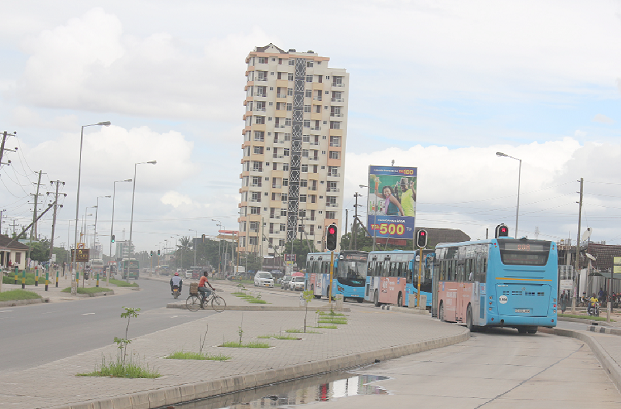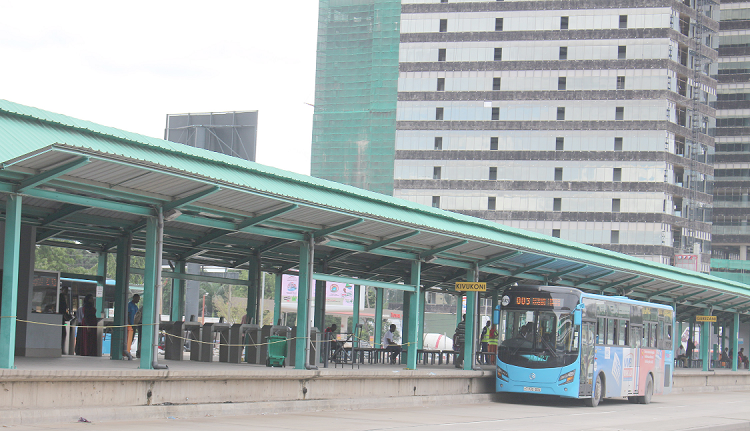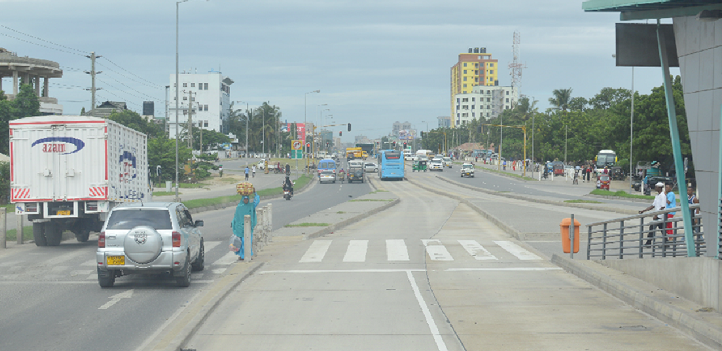
Tanzania makes stride with BRT implementation - Accra has Quality Bus Service
Carrying just about 50 passengers when it was first commissioned last year, the Dar es Salaam Bus Rapid Transit (BRT) currently moves about 200,000 passengers a day in the traffic-prone district of the largest city in Tanzania.
Advertisement
The introduction of the 21-km BRT service has significantly shortened travel time from three hours to about 45 minutes but that is not all. It has also created employment for over 900 people in Tanzania since its wheels hit Dar’s streets in May 2016.
The BRT is an innovative, high-capacity, low-cost public transit solution that can significantly improve urban mobility. It is a permanent integrated system, that uses buses or specialised vehicles on roadways or dedicated lanes to quickly and efficiently transport passengers to their destinations, while offering the flexibility to meet transit demand.

A dedicated lane for the buses
A Transportation Planning Expert working with the Dar Rapid Agency (DART), Mr Fanuel Karugendo, told 74 journalists from across Africa that heavy vehicular traffic congestion characterised by the emission of CO2 necessitated the visualisation of the project in 2002.
However, it was not until 2007 that the DART was established, and it has since worked closely with private sector companies to achieve a full-fledged BRT infrastructure many African cities can only dream of.
Mr Karugendo was briefing journalists who were in Tanzania for a one-week workshop on urbanisation in Africa.
Prior to its introduction, Dar had only four types of transportation - Daladala (mini buses), bajaji (tricycles), bodaboda (motorcycles) and private cars. The low occupancy nature of these forms of transportation resulted in heavy gridlock in the peak hours such that drivers could spend more than three hours commuting on very short journeys. What that also meant was that there was heightened emission of CO2, as well as other negative environmental impacts associated with such forms of transportation. Those forms of transportation were also inefficient, expensive and unsafe.
The BRT
Currently DART, with financial support from the World Bank, the African Development Bank and the government of Tanzania, has been able to implement the phase one of the project out of the six phases envisioned for the city. The phase one is a 21-km full-fledged BRT infrastructure with dedicated right of way, five terminals, six corridors and a bus depot with the capacity to house 360 buses. Presently, DART has in its fleet 140 buses and operates a 19-hour service from 0500 hours to midnight. Each bus carries about 160 people per trip, and makes at least 11 trips daily. As part of the project, a feeder network was also developed to move commuters from the communities to the trunk roads.
To ensure efficiency in service delivery and revenue mobilisation, Mr Karugendo stated that DART worked with different companies in the private sector for ticketing, fare collection and fund management.
Rationale for project
An extract from a World Bank report indicates that Dar es Salaam is considered one of the fastest-growing urban centres in the region, with a population that has been growing rapidly at a rate of 6.5 per cent, up from 2.5 million inhabitants in 2002 to 4.4 million in 2012. It is projected that the population could reach 10 million by 2027, thus attaining ‘mega city’ status.
However, this growth has come with challenges such as traffic congestion, whose costs have been disproportionately high. The World Bank’s estimates show that residents of Dar es Salaam spend approximately 34 per cent of their average monthly incomes on transportation, limiting resources, including time, for productive work.
A presentation by Mr Karugendo indicated that daladala was the most popular form of public transport. In a chart, daladala formed 62 per cent, walking 17 per cent, motorcycle/train two per cent, and driving car 11 per cent and that came with its own challenges.

A stationed bus in one of the terminals
BRT phase two in Dar
With the successful implementation of the phase one, the World Bank is supporting DART to begin the phase two of the project. The phase two involves the construction of infrastructure that includes 20.3km of exclusive BRT lanes and Non-Motorised Transport (NMT) facilities along Kilwa Road corridor and part of Kawawa Road. The project corridor traverses from Mbagala Area in the Temeke District to the Central Business District where it connects with phase one of the BRT system at the Kariakoo hub. The project is expected to benefit an estimated population of at least 1.2 million, representing some 25 percent of the Dar es Salaam City’s population. It will be implemented over a four-year period, 2016 to 2020.
Accra Quality Bus Service
It was meant to be a BRT system but the current infrastructure allows only the implementation of a Quality Bus Service (QBS) on the Central Business District (CBD) to Pokuase corridor.
Accra’s inability to implement a full blown BRT is largely attributed to the lack of a dedicated route which would have given the buses the rapid transit it required under a BRT system.
Ghana’s BRT, implemented under the Urban Transport Project (UTP), was jointly funded by the World Bank, the Agence Francaise de Development (AFD), the government of Ghana and the Global Environment Facility Trust Fund at a cost of $95 million.
The implementation of the BRT, which started in 2007, has faced many challenges key being the stiff resistance from private transport operators between 2008 and 2009.
The Department of Urban Roads (DUR) had earlier planned to execute an advanced type of the BRT on the Accra-Mallam-Kasoa corridor which resulted in the construction of a flyover across the railway line on the Graphic Road in Accra. That project has been shelved for now because of inadequate funding, an official of DUR had told the Daily Graphic in an interview.
The Head of the Greater Accra Passenger Executive (GAPTE), the institution implementing the project, Mr Sampson Gyamena, in an interview told the paper that patronage of Accra’s QBS had been increasing steadily since the project took off in December 2016 with 40 buses.
In December 2016 for instance, GAPTE recorded 1,400 passengers on a daily, in January it was 3,000 and currently, patronage is about 8,500 passengers a day.

A moving bus on its lane
Accra is operating only one corridor with three routes - Amasaman Semi Express Ofankor-Tudu and Achimota-Tudu.
According to Mr Gyamena, the buses are being operated by former ‘trotro’ drivers from the Ghana Private Road Transport Union (GPRTU), Progressive Transport Owners Association (PROTOA) and Cooperative who have formed limited liability companies and recruited about 100 drivers to run the routes.
Final preparations, he hinted, were being made to begin yet another QBS on the Adenta-Tudu corridor by the end of the last quarter of this year.
“We expect to implement the full BRT on the Kasoa corridor,” he stated.



